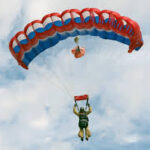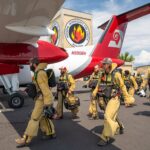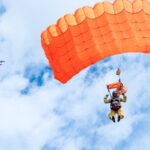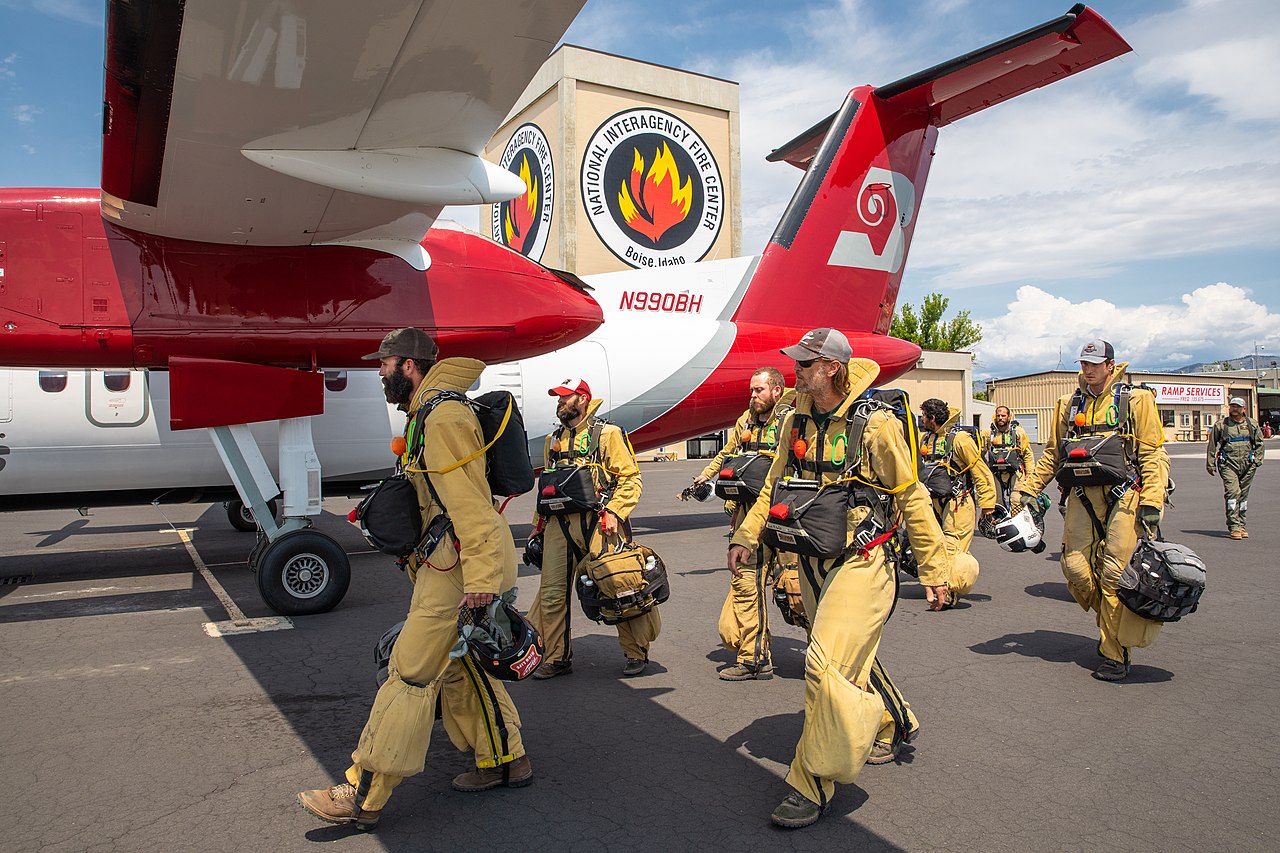
Bureau of Land Mangement smokejumpers prepare for a training jump in Boise, Idaho. (DOI/Neal Herbert)
By: Emily Lawson
Introduction
Smokejumping, one of the most dangerous and demanding professions in the world, represents the epitome of courage, endurance, and dedication. These elite wildland firefighters are tasked with parachuting into remote and inaccessible areas to combat wildfires, often being the first on the scene to suppress fires before they spread. The profession is a blend of skydiving, firefighting, and wilderness survival, requiring a unique set of skills and an unwavering commitment to protecting lives, property, and the environment. This article delves into the history, training, challenges, and evolution of smokejumping, shedding light on the extraordinary individuals who risk their lives to fight fires from the skies.
1. The Origins of Smokejumping
Smokejumping as a firefighting technique began as a solution to a critical problem: how to quickly deploy firefighters to wildfires in remote, rugged terrains that were otherwise inaccessible by vehicle or on foot. The concept of parachuting firefighters into these areas was first proposed in the early 1930s, but it wasn’t until the late 1930s and early 1940s that the idea began to take shape.
The first experimental jumps were conducted in 1939 by the U.S. Forest Service. On July 12, 1940, two Forest Service employees, Rufus Robinson and Earl Cooley, made the first operational smokejumping parachute descent into a fire in Idaho’s Nez Perce National Forest. This successful operation marked the birth of smokejumping as a specialized firefighting method. The early smokejumpers were pioneers, facing the unknown with little more than basic parachutes, rudimentary gear, and sheer determination.
During World War II, smokejumping gained further prominence when civilian public service (CPS) smokejumpers, many of whom were conscientious objectors, served as part of the effort to protect American forests. These early smokejumpers laid the foundation for what would become an essential component of modern wildfire management.
2. The Evolution of Smokejumping Equipment and Techniques
Over the decades, smokejumping has evolved significantly in terms of equipment, techniques, and overall strategy. The early smokejumpers relied on military surplus parachutes and basic protective gear, which offered limited safety and comfort. As the profession developed, so did the technology and equipment used by smokejumpers.
Parachutes: Early parachutes were cumbersome and difficult to control, often leading to hard landings and injuries. Modern smokejumpers now use specially designed ram-air parachutes that offer better maneuverability and control, allowing them to land accurately in tight, confined spaces. These parachutes are tailored for the unique demands of smokejumping, enabling firefighters to descend into rugged terrain with greater precision.
Protective Gear: In addition to the advancements in parachute technology, the protective gear worn by smokejumpers has also seen significant improvements. Early smokejumpers wore basic clothing and gear that provided minimal protection against the elements and potential injuries. Today, smokejumpers are equipped with fire-resistant jumpsuits, helmets with built-in communications, heavy-duty boots, and gloves designed to protect against cuts, burns, and abrasions. This modern gear allows smokejumpers to operate more safely in the challenging environments they face.
Firefighting Equipment: The tools and equipment used by smokejumpers have also evolved to meet the demands of modern wildfire suppression. While traditional tools like Pulaskis (a combination of an axe and a hoe) and shovels are still essential, smokejumpers now carry advanced firefighting equipment, including portable water pumps, chainsaws, and specialized fire shelters. These tools are crucial for creating firebreaks, extinguishing hot spots, and protecting themselves in case of an unexpected flare-up.
Communications and Navigation: One of the most significant advancements in smokejumping has been the development of communications and navigation technology. Early smokejumpers relied on maps and compasses to navigate, often with limited or no radio communication. Today, smokejumpers are equipped with GPS devices, two-way radios, and satellite phones, allowing them to maintain communication with base operations and other firefighting teams. This technology enhances coordination, safety, and efficiency during firefighting operations.
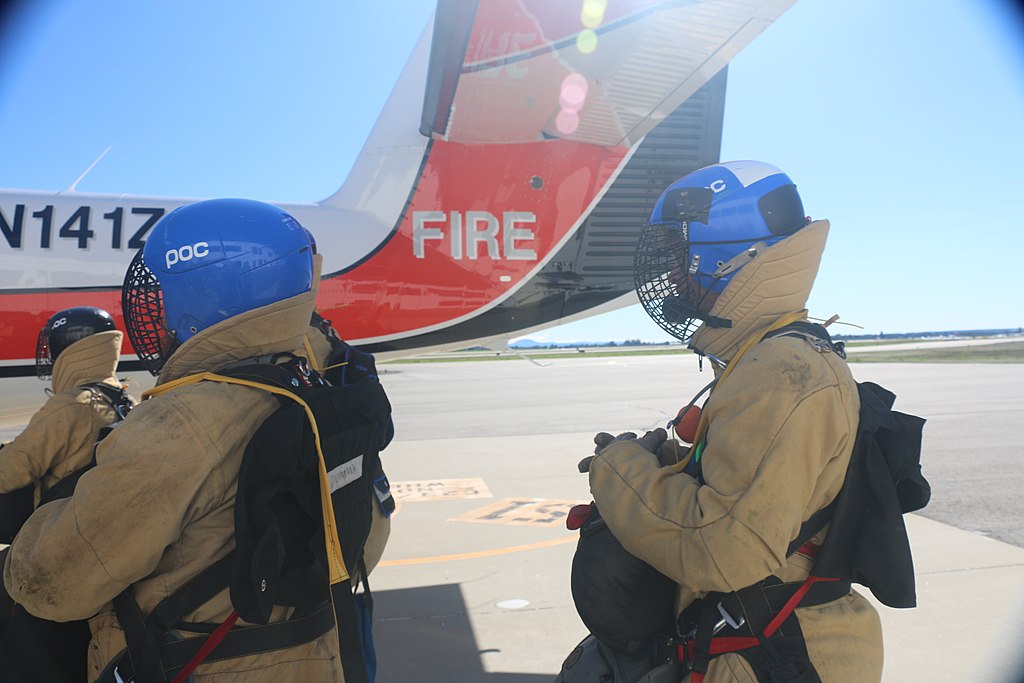
3. The Training of a Smokejumper
Becoming a smokejumper is not for the faint of heart. The training process is grueling, designed to test the physical, mental, and emotional limits of candidates. Smokejumpers must be in peak physical condition, possess exceptional firefighting skills, and be able to operate effectively in isolated, high-pressure environments.
Physical Fitness: The physical demands of smokejumping are extreme. Candidates must undergo rigorous physical fitness tests that include running, weightlifting, push-ups, pull-ups, and other exercises designed to assess their strength, endurance, and agility. Smokejumpers must be able to carry heavy loads, sometimes up to 115 pounds of gear, through difficult terrain for extended periods. Additionally, candidates are trained in parachute landing falls (PLFs), a technique that reduces the impact of landing in rough terrain.
Parachute Training: Parachute training is a core component of smokejumper training. Candidates must complete multiple jumps, both from static lines and freefall, to demonstrate their ability to safely exit an aircraft, control their descent, and land in challenging environments. This training includes jumps into forested areas, steep slopes, and other difficult terrain, simulating the conditions they will face during actual firefighting missions.
Firefighting Skills: In addition to parachute training, smokejumpers must also be highly skilled in wildland firefighting techniques. This includes training in fire behavior, fireline construction, and the use of firefighting tools and equipment. Smokejumpers must be able to quickly assess a fire’s behavior, determine the best strategy for containment, and execute their plan efficiently.
Survival Training: Smokejumpers often operate in remote, wilderness areas where they may be isolated for extended periods. Survival training is a critical component of their preparation, teaching them how to find water, build shelters, and navigate in the wilderness. Smokejumpers must be self-sufficient and capable of surviving on their own until they can be extracted or until additional firefighting resources arrive.
Mental Toughness: Beyond physical and technical skills, smokejumpers must possess exceptional mental toughness. The job demands quick decision-making, the ability to remain calm under pressure, and the resilience to continue fighting fires even when faced with exhaustion, danger, and isolation. Smokejumper training is designed to push candidates to their limits, ensuring that only the most capable individuals are selected for the job.
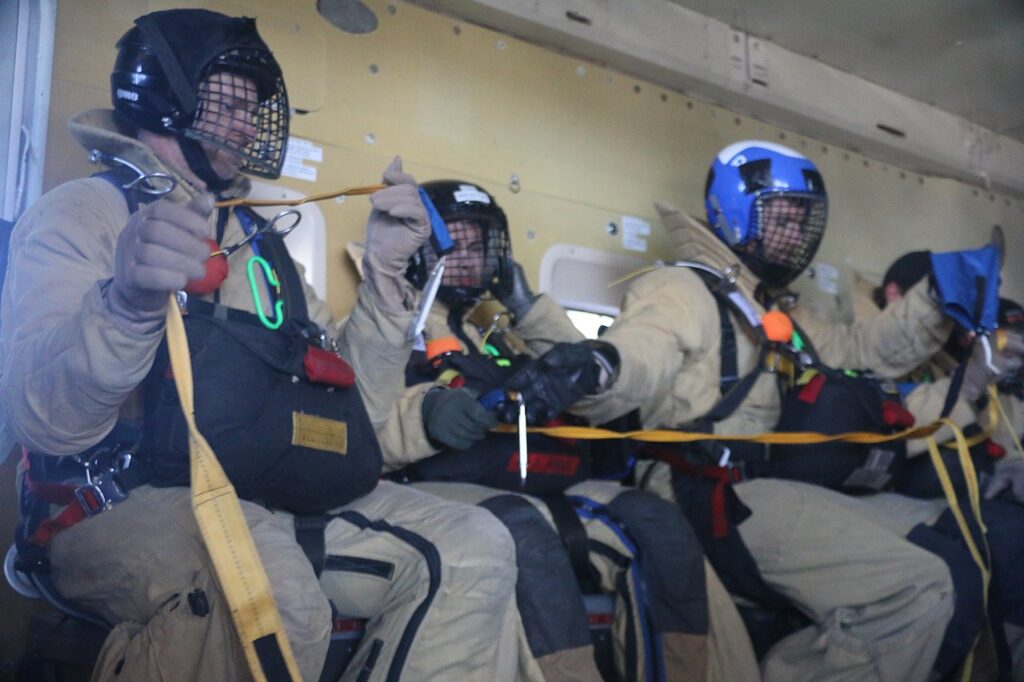
4. The Role of Smokejumpers in Wildfire Suppression
Smokejumpers play a critical role in wildfire suppression, particularly in remote areas where traditional firefighting resources are not readily available. Their ability to rapidly deploy to inaccessible locations allows them to be the first line of defense against wildfires, often preventing small fires from growing into large, uncontrollable blazes.
Initial Attack: The primary mission of smokejumpers is to conduct “initial attack” operations. This involves parachuting into the vicinity of a wildfire shortly after it has been detected and working to contain it before it can spread. Smokejumpers are typically deployed to wildfires that are in remote areas or in locations where ground access is difficult or time-consuming. Their rapid response can be crucial in keeping a fire small and manageable.
Building Firelines: Once on the ground, smokejumpers begin constructing firelines, which are trenches or cleared areas that serve as barriers to prevent the fire from spreading. This is done using a combination of hand tools, chainsaws, and other equipment. The goal is to remove all combustible material along the fire’s edge, creating a break that the fire cannot cross. Smokejumpers may also use controlled burns to eliminate fuel in the path of the fire, further reducing its potential to spread.
Suppressing Hot Spots: In addition to building firelines, smokejumpers are tasked with extinguishing hot spots, which are areas where the fire is still active. This may involve digging out smoldering embers, applying water or fire retardant, and ensuring that the fire is completely extinguished in those areas. Smokejumpers must be thorough in this process, as any remaining embers can reignite and cause the fire to spread.
Evacuating At-Risk Areas: In some cases, smokejumpers may be called upon to assist with the evacuation of people or animals from areas threatened by a wildfire. This can be a challenging and dangerous task, particularly if the fire is rapidly advancing. Smokejumpers must be able to navigate through smoke, flames, and difficult terrain to reach those in need and guide them to safety.
Extended Operations: While smokejumpers are often the first on the scene, their role does not end with the initial attack. They may be required to stay on the fireline for several days, working to contain and extinguish the fire. During extended operations, smokejumpers must be self-sufficient, carrying all necessary supplies, including food, water, and shelter, in their packs. They may also work in conjunction with other firefighting teams, coordinating efforts to control and extinguish the fire.
5. The Challenges and Dangers of Smokejumping
Smokejumping is one of the most dangerous professions in the world, with risks that go beyond the obvious hazards of parachuting into a wildfire. The challenges and dangers faced by smokejumpers are numerous, and every jump carries with it the potential for injury or death.
Parachuting Risks: Parachuting into a wildfire presents a unique set of challenges. Smokejumpers must contend with unpredictable winds, visibility issues due to smoke, and the risk of landing in rough or inaccessible terrain. A misjudged landing can result in serious injuries, including broken bones, concussions, or worse. Even a successful landing can

